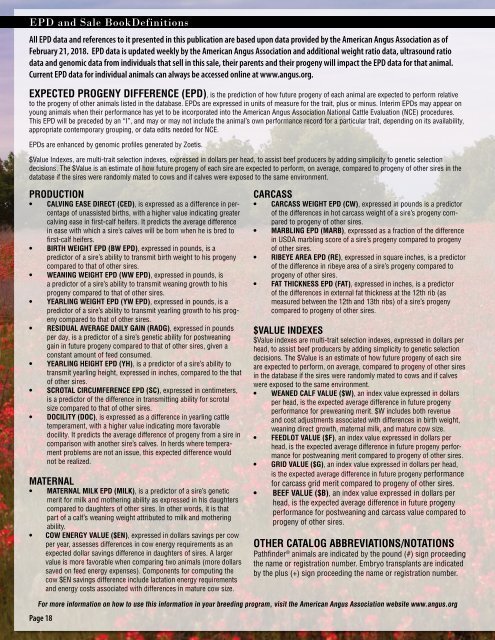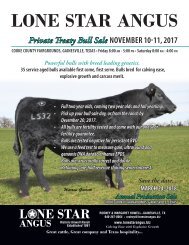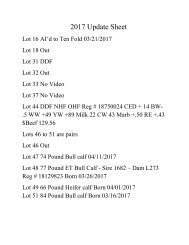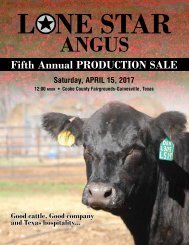Create successful ePaper yourself
Turn your PDF publications into a flip-book with our unique Google optimized e-Paper software.
EPD and Sale BookDefinitions<br />
All EPD data and references to it presented in this publication are based upon data provided by the American Angus Association as of<br />
February 21, 2018. EPD data is updated weekly by the American Angus Association and additional weight ratio data, ultrasound ratio<br />
data and genomic data from individuals that sell in this sale, their parents and their progeny will impact the EPD data for that animal.<br />
Current EPD data for individual animals can always be accessed online at www.angus.org.<br />
EXPECTED PROGENY DIFFERENCE (EPD), is the prediction of how future progeny of each animal are expected to perform relative<br />
to the progeny of other animals listed in the database. EPDs are expressed in units of measure for the trait, plus or minus. Interim EPDs may appear on<br />
young animals when their performance has yet to be incorporated into the American Angus Association National Cattle Evaluation (NCE) procedures.<br />
This EPD will be preceded by an “I”, and may or may not include the animal’s own performance record for a particular trait, depending on its availability,<br />
appropriate contemporary grouping, or data edits needed for NCE.<br />
EPDs are enhanced by genomic profiles generated by Zoetis.<br />
$Value Indexes, are multi-trait selection indexes, expressed in dollars per head, to assist beef producers by adding simplicity to genetic selection<br />
decisions. The $Value is an estimate of how future progeny of each sire are expected to perform, on average, compared to progeny of other sires in the<br />
database if the sires were randomly mated to cows and if calves were exposed to the same environment.<br />
PRODUCTION<br />
• CALVING EASE DIRECT (CED), is expressed as a difference in percentage<br />
of unassisted births, with a higher value indicating greater<br />
calving ease in first-calf heifers. It predicts the average difference<br />
in ease with which a sire’s calves will be born when he is bred to<br />
first-calf heifers.<br />
• BIRTH WEIGHT EPD (BW EPD), expressed in pounds, is a<br />
predictor of a sire’s ability to transmit birth weight to his progeny<br />
compared to that of other sires.<br />
• WEANING WEIGHT EPD (WW EPD), expressed in pounds, is<br />
a predictor of a sire’s ability to transmit weaning growth to his<br />
progeny compared to that of other sires.<br />
• YEARLING WEIGHT EPD (YW EPD), expressed in pounds, is a<br />
predictor of a sire’s ability to transmit yearling growth to his progeny<br />
compared to that of other sires.<br />
• RESIDUAL AVERAGE DAILY GAIN (RADG), expressed in pounds<br />
per day, is a predictor of a sire’s genetic ability for postweaning<br />
gain in future progeny compared to that of other sires, given a<br />
constant amount of feed consumed.<br />
• YEARLING HEIGHT EPD (YH), is a predictor of a sire’s ability to<br />
transmit yearling height, expressed in inches, compared to the that<br />
of other sires.<br />
• SCROTAL CIRCUMFERENCE EPD (SC), expressed in centimeters,<br />
is a predictor of the difference in transmitting ability for scrotal<br />
size compared to that of other sires.<br />
• DOCILITY (DOC), is expressed as a difference in yearling cattle<br />
temperament, with a higher value indicating more favorable<br />
docility. It predicts the average difference of progeny from a sire in<br />
comparison with another sire’s calves. In herds where temperament<br />
problems are not an issue, this expected difference would<br />
not be realized.<br />
MATERNAL<br />
• MATERNAL MILK EPD (MILK), is a predictor of a sire’s genetic<br />
merit for milk and mothering ability as expressed in his daughters<br />
compared to daughters of other sires. In other words, it is that<br />
part of a calf’s weaning weight attributed to milk and mothering<br />
ability.<br />
• COW ENERGY VALUE ($EN), expressed in dollars savings per cow<br />
per year, assesses differences in cow energy requirements as an<br />
expected dollar savings difference in daughters of sires. A larger<br />
value is more favorable when comparing two animals (more dollars<br />
saved on feed energy expenses). Components for computing the<br />
cow $EN savings difference include lactation energy requirements<br />
and energy costs associated with differences in mature cow size.<br />
CARCASS<br />
• CARCASS WEIGHT EPD (CW), expressed in pounds is a predictor<br />
of the differences in hot carcass weight of a sire’s progeny compared<br />
to progeny of other sires.<br />
• MARBLING EPD (MARB), expressed as a fraction of the difference<br />
in USDA marbling score of a sire’s progeny compared to progeny<br />
of other sires.<br />
• RIBEYE AREA EPD (RE), expressed in square inches, is a predictor<br />
of the difference in ribeye area of a sire’s progeny compared to<br />
progeny of other sires.<br />
• FAT THICKNESS EPD (FAT), expressed in inches, is a predictor<br />
of the differences in external fat thickness at the 12th rib (as<br />
measured between the 12th and 13th ribs) of a sire’s progeny<br />
compared to progeny of other sires.<br />
$VALUE INDEXES<br />
$Value indexes are multi-trait selection indexes, expressed in dollars per<br />
head, to assist beef producers by adding simplicity to genetic selection<br />
decisions. The $Value is an estimate of how future progeny of each sire<br />
are expected to perform, on average, compared to progeny of other sires<br />
in the database if the sires were randomly mated to cows and if calves<br />
were exposed to the same environment.<br />
• WEANED CALF VALUE ($W), an index value expressed in dollars<br />
per head, is the expected average difference in future progeny<br />
performance for preweaning merit. $W includes both revenue<br />
and cost adjustments associated with differences in birth weight,<br />
weaning direct growth, maternal milk, and mature cow size.<br />
• FEEDLOT VALUE ($F), an index value expressed in dollars per<br />
head, is the expected average difference in future progeny performance<br />
for postweaning merit compared to progeny of other sires.<br />
• GRID VALUE ($G), an index value expressed in dollars per head,<br />
is the expected average difference in future progeny performance<br />
for carcass grid merit compared to progeny of other sires.<br />
• BEEF VALUE ($B), an index value expressed in dollars per<br />
head, is the expected average difference in future progeny<br />
performance for postweaning and carcass value compared to<br />
progeny of other sires.<br />
OTHER CATALOG ABBREVIATIONS/NOTATIONS<br />
Pathfinder ® animals are indicated by the pound (#) sign proceeding<br />
the name or registration number. Embryo transplants are indicated<br />
by the plus (+) sign proceeding the name or registration number.<br />
For more information on how to use this information in your breeding program, visit the American Angus Association website www.angus.org<br />
Page 18





